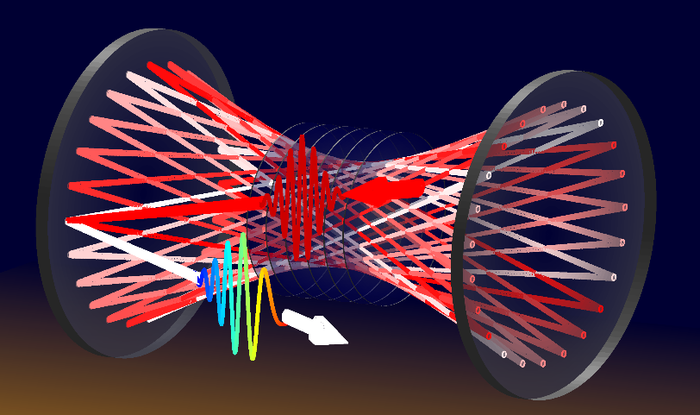A new scientific field called nonlinear optics soon emerged after the first demonstration of the laser in 1960.
 Artist view of the novel scheme for generating broadband light pulses: A nearly monochromatic laser pulse enters a so-called multi-pass cell consisting of two focusing mirrors. Moreover, there is an assembly of glass plates in the cell which causes the broadening of the optical spectrum and also presents a sequence of lenses. The outgoing pulse has a much broader optical spectrum. Image Credit: Ultrafast Science.
Artist view of the novel scheme for generating broadband light pulses: A nearly monochromatic laser pulse enters a so-called multi-pass cell consisting of two focusing mirrors. Moreover, there is an assembly of glass plates in the cell which causes the broadening of the optical spectrum and also presents a sequence of lenses. The outgoing pulse has a much broader optical spectrum. Image Credit: Ultrafast Science.
The peculiar coherence qualities of stimulated emission, the underlying physical mechanism of laser light, have permitted intensities that are substantially larger than incoherent sources by many magnitude orders.
Electrons are driven aggressively by the high intensities so much so that they oscillate at frequencies different from those of the driving light field. The dipole emission that follows can be quite colorful. For decades, waveguides made of optical fiber or laser filaments have been utilized to optimize this effect and create exceptionally broadband light pulses.
Nevertheless, if the laser pulses have too much energy, the fiber will be damaged, and the light filaments will break apart, resulting in the loss of laser radiation’s distinctive spatial features.
A new approach for steering light in an energy-scalable way has been described by researchers from the German Electron-Synchrotron DESY in Hamburg, Germany, and the Helmholtz-Institute Jena, Germany. Two refocusing mirrors and the precise spacing of tiny nonlinear glass panes are used for guiding.
In a study published in Ultrafast Science, scientists stated that light pulses gain more than 30 times their original bandwidth in such a configuration and can be compressed by the same factor. This reduces their duration while significantly improving their peak power.
Notably, such experiments were done with laser pulses that surpassed the peak power limit in glass fibers by a factor of 40. Nevertheless, beam quality and pulse energy stayed high, in spite of propagation through approximately 40 cm of glass in total.
We have elegantly combined two recent approaches to extend the bandwidth of ultrashort pulses. Nevertheless, the optical setup is really simple. All optics we used in our spectral broadening scheme were stock items. This and the excellent noise properties make our approach widely applicable.
Dr. Marcus Seidel, Publication Lead Author, German Electron-Synchrotron DESY
There is a clear trend in ultrafast laser technology towards high average power sources which can often only deliver pulses with picosecond-level durations. Our method presents an energy-, size- and cost-efficient approach to turn these lasers to pulsed sources with only tens of femtosecond duration with gigawatts of peak power.
Dr. Christoph Heyl, Junior Group Leader, DESY, Helmholtz Institute Jena
The timeframe of molecular motion that can be monitored and modulated using ultrashort pulses is known as the femtosecond regime. Furthermore, femtosecond pulses are far too rapid to generate heat following ionization. In laser material processing, this is commonly used.
The pulse compression method has been employed at DESY’s FLASH free-electron laser facility for several months. Scientists have been able to acquire accurate images of molecular dynamics in innovative quantum materials as a result of it.
Our facility users have been very happy with it. We would be delighted, of course, if this technology enables cutting-edge science experiments at DESY and many other institutes around the world.
Dr. Marcus Seidel, Publication Lead Author, German Electron-Synchrotron DESY
Dr. Heyl’s team recently released simulations that illustrate how the proven technique may be extended to terawatt peak powers and joule-level pulse energies. Implementation of such an energy-upscaled experiment will open up new possibilities.
“Spectral broadening and pulse compression have been identified as the key methods for advancing strong-field physics by the 2018 Nobel laureate Gérard Mourou. With the new technology, his prediction may take shape,” added Dr. Heyl.
He further stated “We are already setting up a first compact multi-pass cell-based particle accelerator in our laboratories. We expect that the concept also makes an impact on future radiation therapy and possibly even laser-based fusion.”
In an invited Optica review article by Dr. Anne-Lise Viotti, Dr. Seidel, and coworkers, more information concerning the remarkable qualities as well as the quick technical advancement of the applied technique are discussed.
The authors define interesting prospects enabled by this technology, in addition to outlining the principles of the procedure and exhibiting its state-of-the-art.
Journal Reference:
Seidel M., et al. (2022) Factor 30 Pulse Compression by Hybrid Multipass Multiplate Spectral Broadening. Ultrafast Science. doi.org/10.34133/2022/9754919.